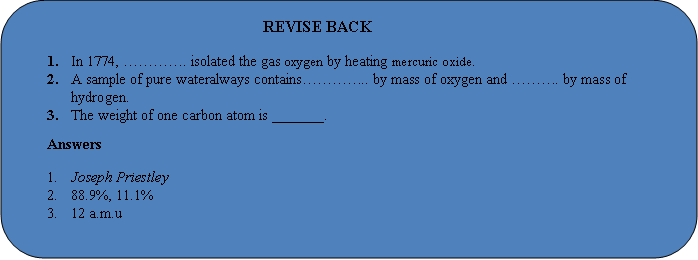Explanation of the laws of chemical combination
Atom and Molecule of Class 9
Dalton’s atomic theory was the first modern attempt to describe the properties of matter in terms of atoms. This theory provides a simple explanation for the laws of chemical combination.
Explanation of law of conservation of mass:
According to Dalton’s atomic theory matter is made up of atoms and number of various types of atoms in the products of a chemical reaction is the same as that of the reactants. As the same number of various atoms in products and reactants will have the same mass, so the total mass of products is equal to the total mass of reactants or the mass remain unchanged during a chemical reaction and this is the law of conservation of mass.
Explanation of law of constant proportion:
According to one of the postulates of Dalton’s atomic theory the number and kind of atoms in a compound is fixed. From this we can infer that a compound is always made up of the same elements combined together in the same proportion by mass and this is the law of constant proportion.
Limitations or drawbacks of dalton’s atomic theory
Dalton’s theory had a few drawbacks. According to Dalton’s postulates,
- An atom is the smallest indivisible particle of an element. However, it is now known that atoms can further be subdivided into elementary particles like electrons, protons, and neutrons.
- Atoms of the same element are identical in all respects, having the same size, shape and structure, and especially mass. Today, we know that atoms of the same element can have slightly different masses. Such atoms are called isotopes.
- Atoms of different elements have different properties and different masses. However, different elements do exist whose atoms have the same mass. Such atoms are called isobars.
Importance of Dalton's theory:
Not with standing these drawbacks, the importance of Dalton’s theory should not be underestimated. He displayed exceptional insight into the nature of matter. His ideas provided a framework that could be modified and expanded by later scientists. Thus John Dalton is often considered to be the father of modern atomic theory.

- Formula Mass
- Monoatomic Ions and Polyatomic Ions
- Laws of Chemical Combination
- Dalton’s Atomic Theory
- Introduction
- Explanation of the laws of chemical combination
- Atoms
- what is Molecule
- How to find Molecular Mass
- Gram Atomic And Gram Molecular Mass
- Some Important Relations Regarding Moles Of Atoms
- Important Formula of Atom and Molecules
- Solved questions
- Exercise 1
- Exercise 2
- Exercise 3
- Exercise 4
- Exercise 5 (True and False)









